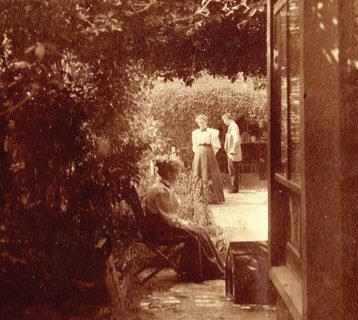To honour 40 years since the death of Sir Alfred Hitchcock, local historian Gary Lewis tells the story of how his interest in the late director spawned a business offering guided tours in Leytonstone Good evening (as Leytonstone’s favourite son himself would say). My name is Gary Lewis, I’m a local historian, public speaker and tour guide on the subject of the late, great film director Sir Alfred Hitchcock. Hitchcock was born on 13 August 1899 in Leytonstone. Known as the Master of Suspense, he directed over 50 feature films before receiving an American Film Institute Life Achievement Award. He made his directorial debut with the silent film The Pleasure Garden in 1925. His first successful film, The Lodger: A Story of the London Fog (1927), helped to shape the thriller genre, while his 1929 film, Blackmail, was the first British ‘talkie’. He died in California on 29 April 1980. I’ve been a resident of Leytonstone for the past 41 years, but my fascination with Hitchcock really began when I was a teenager in the late 1970s. One Sunday night, I stayed up late to watch Psycho on TV. I remember jumping out of my chair at the shower scene, and the screeching violins...
Features
In the third of a series of articles documenting the thoughts of local anti-bullying ambassador Elsa Arnold, the founder of the Spreading Kindness Through E11 initiative explains how we can all effect change I’ve always been someone who has dreamt of ways to make a positive difference and inspire even just a small change in the world. It’s important to me that I am able to have an impact and help others with issues I understand and feel passionately about shaping. When I experienced bullying and struggled with my mental health, my desire and need to help others got stronger, and after struggling so much, I couldn’t stand by knowing that other people were experiencing similar difficulties. I knew and believed I could make a difference. But I’ll be honest, taking the first few steps to speak out and stand up was one of the most terrifying things I have done. It hasn’t always been easy. I knew from the beginning I might get a little bit of backlash. I didn’t expect it to be easy, particularly because the issue was still very sensitive for me at the time. But that was never going to stop me. I knew however...
In the second of a series of articles looking at local historic photos found in a 100-year-old family album, historian Richard Arnopp presents a selection of images of the Hobbs at their Forest Gate home Last month, I introduced the Hobbs family, a talented and interesting clan, some of whom lived locally in Forest Gate and later Ilford. In 2017, I acquired an album, dated 1896–1907, containing over 100 photographs taken by family members. The patriarch of the family was George Wilson Hobbs, a self-employed artist who had been born in Newport, Isle of Wight, in 1838. With his wife, Fanny, and their family, he moved to Forest Gate around 1880 and resided at 35 Bignold Road until his death in 1913. That house was the setting for a number of photographs from the album which will illustrate this instalment. In those days, Forest Gate was rather different to what it is today – a quiet, lower-middle-class suburb containing an island of quite exclusive villas in the Woodgrange Estate. Mrs Dorothy Neal was born in 1912 in the corn chandler’s shop owned by her father in Dames Road – not 100 yards from the home of George Hobbs, with whom...
Equity release is being widely promoted as a way to unlock money tied up in your property. But what are the pros and cons? Geoff Williams from Wiseman Lee explains why it is important to seek legal advice In recent months, you’ve hardly been able to turn on the TV or the radio without an advert for equity release popping up, offering the release of money from your home as a lump sum or as monthly income. Before you take the plunge, it’s important to be aware that there are alternative ways to raise capital by selling and downsizing your property or attracting additional income by renting out a room. Make sure you consider all other options first to ensure that equity release is right for you. If you still feel equity release might be the way forward and you are over 55, it is important to understand what is involved. There are two main types of equity release. The first is a lifetime mortgage. Here, money is borrowed against the value of your home. In the future, when the property becomes vacant, after you pass away or move into residential care, the mortgage is repaid from the sale of...
Should you ditch your car? Kathy Taylor from Wanstead Climate Action assesses your options if you want to stop contributing to air pollution and reducing the lifespan of your neighbours Did you know that a mile of congested urban diesel driving takes about 12 minutes off the life of the rest of the population? This stark fact is one of the many interesting ones to be found in the book There is no Planet B by Mike Berners-Lee. If you needed a reason to scrap your diesel (or give it to a country dweller) apart from the upcoming expanded Ultra Low Emission Zone (ULEZ) area, the fact that an estimated 40,000 people a year in the UK die prematurely from air pollution should persuade you. It’s the nitrogen dioxide and the small particles (PM 2.5s) that are the killers (including those from tyres and brakes). So, what should you do? Of course, the most environmentally friendly alternative is to ditch the car. Living in London is perhaps the easiest place to live without one. If there were more club cars like Zip Car this would be convenient and make economical – as well as environmental – sense: most cars sit doing...
A project which has been bringing the community together by collating wartime memories of Redbridge was hoping to stage a local theatre production this month. Alfie James reports From stories of rationing and being evacuated to blackouts and bombings, the Hope and Glory community theatre project set out to explore what life was like living in Redbridge during the Second World War. We have set up two groups: a group of researchers meeting regularly at Redbridge Museum and a group of local performers using performance techniques to explore what life was like in that period. Thanks to the local press and the power of social media, as well as good old-fashioned word of mouth, the project has already generated a lot of interest. We’ve been overwhelmed by the amount of positive support received by the community and we couldn’t thank you enough. We’ve received emails and telephone calls from residents wanting to share family stories of memories. The project has even reached the wider community too. We had one former resident now living in Canada call us with information and we’re sharing our research with a school in Scotland who are learning about London during the war. The project would...
A talk about local war memorials was due to take place at the Woodford and District branch of the National Trust this month. As with many events, this is likely to be cancelled. So we invited Richard Speller to talk here about Wanstead’s own monument of remembrance. Photo of the Wanstead War Memorial by Geoff Wilkinson Due to the appalling death toll suffered in the 1914–1918 Great War, virtually every family in the land would have known of someone who had lost their life. Thus, within a very short period, war memorials of every different type – stone pillars, statues, windows, plaques – were erected all over the country. These were, in the main, funded by local communities. Of course, these memorials not only list those who died in the First World War but also the second (1939–1945) and beyond, and the Wanstead memorial commemorates Marine Tom Curry, who lost his life in Afghanistan in 2007. War memorials, as we know them, only really started appearing after the Crimean War in the 1850s. Prior to that, sadly, participants who had been killed were buried in mass graves without any identification at all. The movement gathered pace following the Boer wars, primarily due to...
In the 21st of a series of articles charting the Wild Wanstead project, Iain Ambler considers the natural history of George Green and its future as a special site for wildlife in Wanstead. Photo by Geoff Wilkinson George Green has an interesting environmental history that we can see many remnants of today. It appears to be a fragment of old acid grassland or heathland, probably in or at the margins of Epping Forest. In 1683, John Evelyn visited Wanstead and recorded the costly planting of avenues of trees by Sir Josiah Child around his recently acquired estate. The remaining massive sweet chestnut trees standing on the Green today (four in a line, three together, one towards the St Mary’s end of the green) formed part of one of these double avenues of trees radiating out for some distance from the focal point of the grand house, which was located on part of what is now Wanstead’s golf course. With the break-up of the Wanstead Estate in the 19th century, the Green remained as a patch of poor quality pasture surrounded by buildings. It is owned by the City of London Corporation and protected by the Epping Forest Act of 1878. The day-to-day...
Richard Arnopp was one of several participants in last month’s Museum of London Archaeology workshop exploring the history and secrets of Wanstead Park’s Temple Anything to do with the history of Wanstead Park is almost guaranteed an audience and, with that in mind, Epping Forest hosted two free archaeology workshops in the park last month as part of Layers of London, an interactive online mapping project. The events – led by Paul McGarrity of Museum of London Archaeology – took place in the Temple, a building dating from about 1760, originally constructed to house a menagerie. Paul explained that archaeology isn’t just about digging - archaeologists record buildings which are still standing too. He said that the analysis of buildings is based on the same principles as other archaeological fieldwork. In excavations, archaeologists use the sequence of buried layers to reconstruct the history of a site, while the development of buildings is phased using the relationship between 3D structures. Paul began by saying protection for archaeology had increased since 1990 with measures which had greatly increased the level of recording. In the case of a standing building, this would depend on its nature and the purpose for which the record...
There’s a team of dedicated Wanstead folk working on a daily basis to help local rough sleepers and those less fortunate than many of us. Could you help them? Samantha Earl reports John Wagstaff of Petty Son and Prestwich is one of these dedicated folk who can often be found sorting, organising and distributing various donations to different shelters and food banks. And until recently, John was helping out Wanstead charity worker Frank Charles and T-Space’s Jason Harris every Friday by giving out clothes, sleeping bags and other much-needed items at the Stratford Centre. Every week, John, Frank and Jason would arrive at the Stratford Centre at 6am – early because those sleeping rough are moved on by security. But out of sight shouldn’t ever be out of mind, so the team arrived with a large estate SUV full to the brim with bags of donations, generously provided by the amazing Wanstead community. Frank brought a huge bag of food to hand out, while John and Jason set up a large table of the clothes. The team encountered 20 to 40 rough sleepers each week, and one in 10 were female. In the team’s experience, these people were often timid...
As the Wanstead Winter Night Shelter project comes to an end, Revd Canon Ann Clarke reflects on 13 weeks of community generosity, local business support and numerous grateful guests The Wanstead Winter Night Shelter closed its doors at the end of March after a successful inaugural season. This is down to the excellent organisation and experience of the Forest Churches Emergency Night Shelter (FCENS) model, and the wonderful number of local volunteers who ran the shelter each week. The volunteers came from many different backgrounds, some of faith and some of none.The amazingly generous donations, both financial and in kind, made it possible to give the very best we could to our guests. We gave a warm welcome, food, shelter, clothing and toiletries to up to 30 guests each week (mostly men, but a few women). We have also discovered that Jenga, Connect 4 and chess were very popular with our guests! Local support has been exceptional; businesses turned up with bread, pastries, savouries, even complete meals for 30. Among those who have donated are Horizon Patisserie, Leytonstone; The Duke, Wanstead; La Bakerie, Wanstead; The Rotisserie Company; and Luppolo, Wanstead. When we had excess, guests were able to take ‘packed...
Paul Kaufman, Chair of East London Humanists, introduces Leo Barasi, the speaker who was scheduled for the group’s April event and who would have been explaining why climate change apathy matters, and how it can be beaten Leo Barasi is a leading thinker, speaker and writer on climate change, politics and public opinion. Broadcast appearances include Radio 4’s The Moral Maze and World Tonight, Radio 5 Live, Channel 4 and Sky. His acclaimed book, The Climate Majority: Apathy and Action in an Age of Nationalism, addresses one of the greatest challenges we face today. Writing in The Guardian last October, Leo paid tribute to Extinction Rebellion for succeeding in using protest earlier in the year to transform public debate. But he predicted challenges for the next round of mass protest about to take place that month. The novelty of such actions would have worn off and the police would move more decisively. Perhaps the biggest challenge Leo identified is the public attention span. He points out that the overwhelming majority do now support the aim of zero net emissions. Many believe the argument is won and that blocking the streets serves little purpose. But few pay attention to policy detail or punish...












